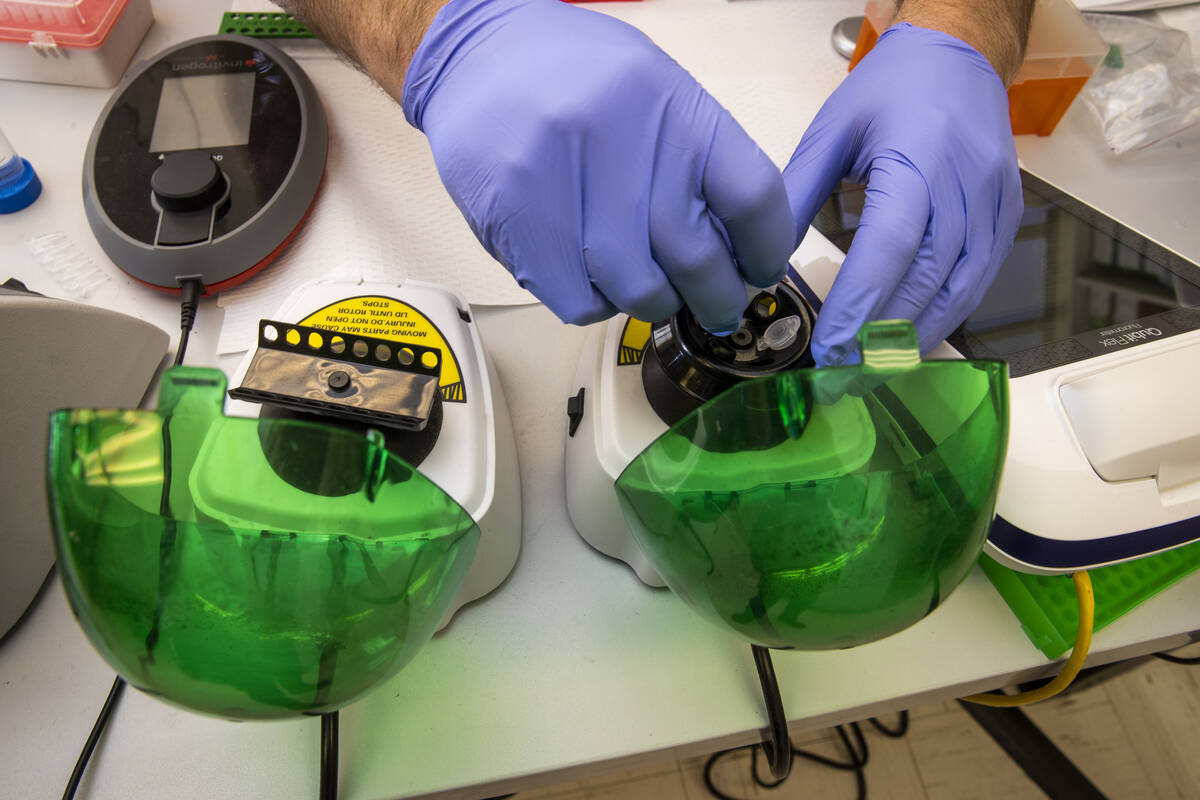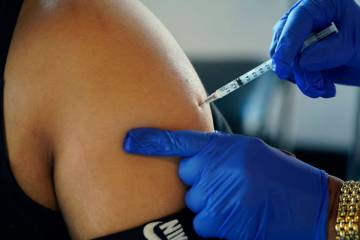How worried should Southern Nevadans be about the new variant?
Just as the omicron wave of COVID-19 cases showed signs of receding, the Southern Nevada Health District on Friday announced that it had detected the state’s first case of a worrisome new variant known as BA.2.
What worries public health officials is the early evidence suggesting that this variant can spread from person to person more easily than even omicron, which is more transmissible than earlier strains of the virus.
Although it’s too soon to say whether BA.2 will slow the current decline in new cases — or even trigger another wave of infections — health officials say there is no reason to panic.
They say that BA.2 does not appear to result in more severe illness than does omicron, which is characterized by generally milder illness. BA.2 and omicron, also known as BA.1, share a common viral ancestor and are closely related in terms of genetics.
“Currently there is no evidence that the BA.2 lineage is more severe than the BA.1 lineage,” said Jade Fulce with the Centers for Disease Control and Prevention.
Neither is there evidence that the new variant is better than omicron at evading the immune protection afforded by vaccination or prior infection, health authorities say.
But data from Denmark, where the variant is now the dominant coronavirus strain, as well as from the U.K. suggests that it can spread more easily.
It appears that BA.2 “can still infect people that have been vaccinated and boosted with a fair degree of transmissibility,” said Mark Pandori, director of the Nevada State Public Health Laboratory in Reno.
Few cases so far
Nationwide, 194 cases of BA.2 have been identified in 29 states, according to Outbreak.info, a project by Scripps Research supported by the federal government. Cases of any particular variant are identified through genetic analysis by laboratories of a sampling of positive COVID-19 tests.
“Although the BA.2 lineage has recently increased in proportion in some countries, it remains a very low proportion of circulating viruses in the United States and globally,” Fulce said in an email.
Researchers who study wastewater, or sewage, in Clark County for early clues about the virus are seeing few signs of BA.2. The researchers analyze levels and strains of the virus, which passes through the body and appears in sewage.
They detected BA.2 in a sample from the Las Vegas Strip two weeks ago, said Edwin Oh, an associate professor of neurogenetics at UNLV. But the variant has not been spotted since then, indicating that wastewater levels of the variant remain low or undetectable.
Genetic analysis of wastewater can detect that a new variant is emerging a week or even a month before a similar analysis of samples of positive COVID-19 test results in public health laboratories, he said.
“We will be monitoring this very closely because of what we are observing in Denmark and possibly the U.K., where BA.2 has overtaken BA.1,” the researcher said in an email.
Even with the emergence of BA.2, overall levels of the virus in wastewater are continuing to decline, according to researcher Daniel Gerrity, a microbiologist with the Southern Nevada Water Authority
He expects that the levels of the coronavirus in wastewater — and, in turn, numbers of cases — will continue their downward trend.
“That’s assuming that we don’t have any major behavioral changes or policy changes or variant changes or things like that” that might lead to increased disease transmission, Gerrity said in an interview.
For now, COVID-19 metrics are trending in the right direction.
If BA.2 does spread rapidly, “it could cause a complete change in direction” resulting in an increase in cases, said Brian Labus, an assistant professor of epidemiology and biostatistics at UNLV’s School of Public Health. “But right now, we’re not seeing that.”
In countries such as Denmark and India where BA.2 emerged earlier, the variant hasn’t triggered a new surge in cases, said Cassius Lockett, director of disease surveillance and control for the Southern Nevada Health District. But it seems to be slowing the downward trend in cases.
“It’s more like the tail of existing cases just extends out further,” Lockett said during a COVID-19 briefing on Wednesday.
Despite the presence now of BA.2, Pandori believes it’s likely that COVID-19 cases will continue to decline for the near term, as they did this time last year.
‘There’s a pattern’
“There’s a pattern, and that pattern is that cases go up in the wintertime,” followed by a decline in spring and a new surge in the summer, he said.
Although the more transmissible alpha variant emerged in the U.S. in February and March of last year, case numbers continued to decline until the delta surge in the summer, Pandori said.
“So the variant itself doesn’t seem to necessarily be the driver,” he said. “It’s more importantly the time of the year that seems to be the driver.”
Like some other scientists, Pandori believes that the virus probably will continue to evolve in ways that produce milder disease but allow it to spread more easily.
Eventually, the virus could behave more like a seasonal flu or cold, and like the flu, require for the best protection a booster shot based on early indications of what variants will be circulating that season.
“Maybe a take-home message for people is that we’re headed in that direction,” he said.
The Southern Nevada Health District recommends that the community continue to take precautions against the virus, including getting fully vaccinated and boosted.
“Reducing disease transmission through vaccination is one of the best ways to slow the emergence of new variants,” representative Stephanie Bethel said in an email.
Contact Mary Hynes at mhynes@reviewjournal.com or 702-383-0336. Follow @MaryHynes1 on Twitter.











































